Menus
- Just ride a motorcycle
- Cheer up to the limiter
- Honda CB 650 F without high-frequency screeching
- Unexpected strong vibrations
- Zags extremely light-footed around the corner
- Technical specifications
- The 90 hp class is gaining momentum
- Noticed
- Tire transparency
- MOTORCYCLE measurements
- MOTORCYCLE scoring
- Conclusion
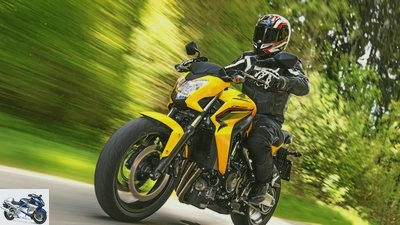
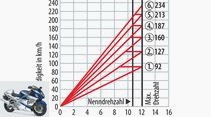
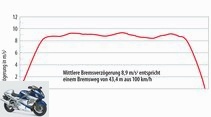
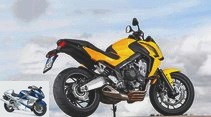
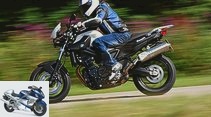
29 photos
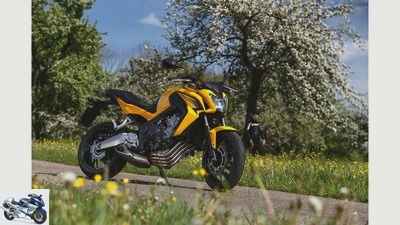
1/29
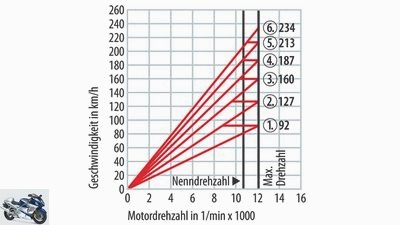
2/29
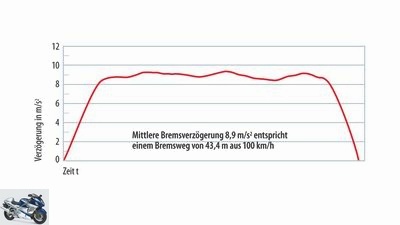
3/29
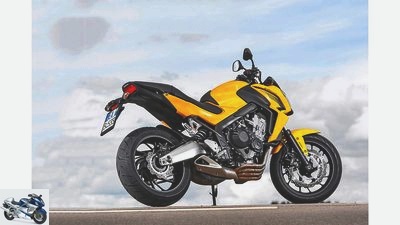
4/29
Despite normal ground clearance and comfortable ergonomics, the CB 650 F allows you to carve through the curve at a fairly slanting angle.
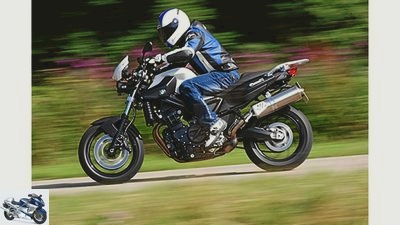
5/29
Competition: BMW F 800 R.
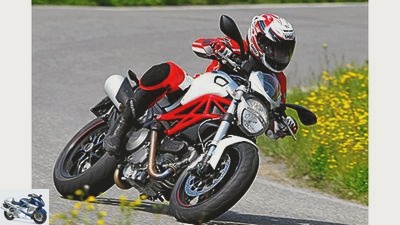
6/29
Competition: Ducati Monster 796.
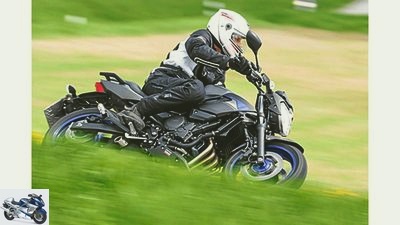
7/29
Competition: Yamaha XJ6.
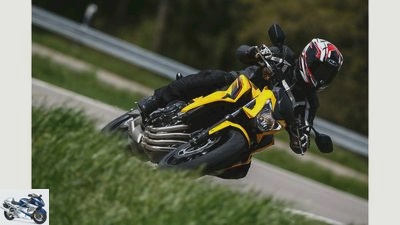
8/29
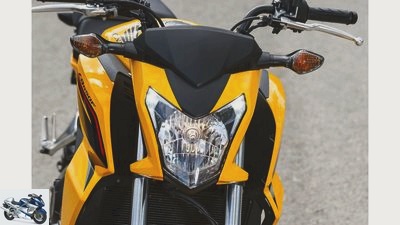
9/29
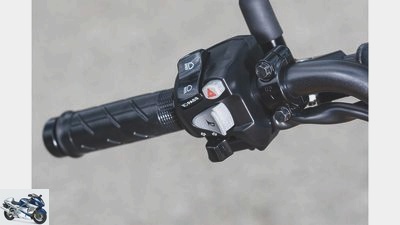
10/29
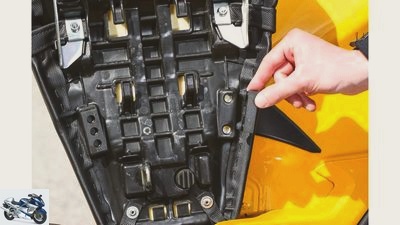
11/29

12/29
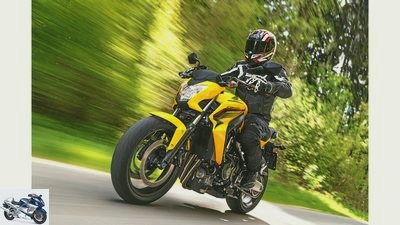
13/29
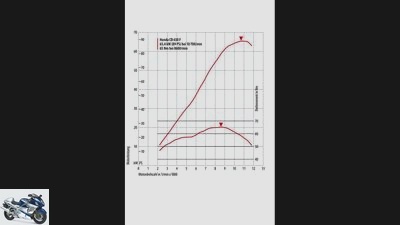
14/29
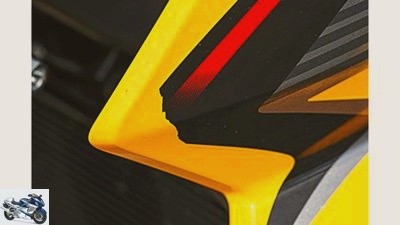
15/29
Noticeable negatively: The sticker on the side panel that was not painted over.
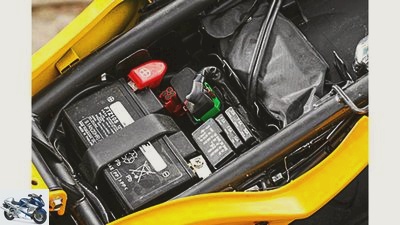
16/29
Noticeable positively: the storage compartment.
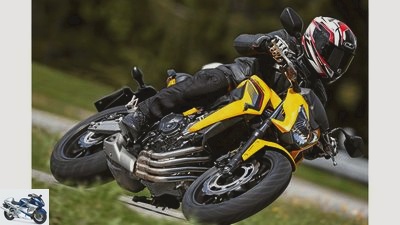
17/29
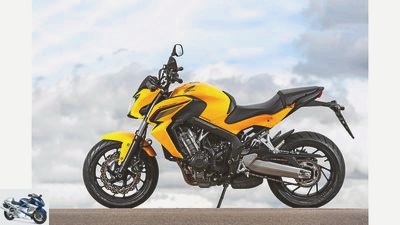
18/29
The new Honda CB 650 F is far from glamorous, but not entirely uninteresting.
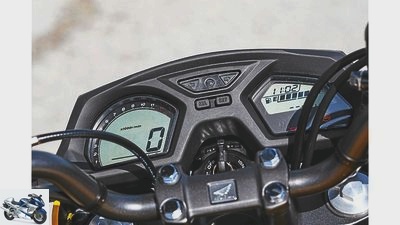
19/29
The view of the two-part LCD cockpit is made difficult by the Bowden cables. For this, the 650 offers a remaining range display.
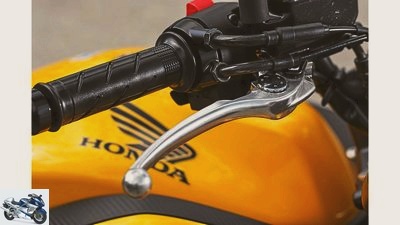
20/29
The brake lever can be adjusted in width. The two-piston floating calipers are finely dosed.
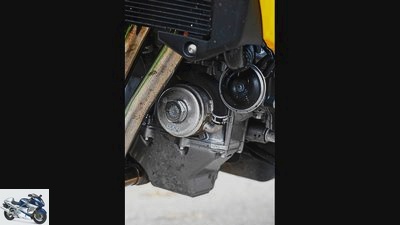
21/29
Is that the oil filter? No, but the heat exchanger. The oil filter is located behind the oil pan or in front of the cat.
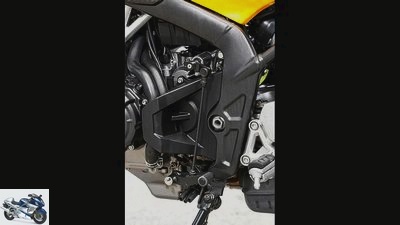
22/29
Honda has built better transmissions. Whether it’s because of this endlessly long shift linkage?
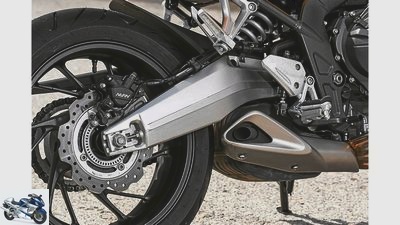
23/29
Here the price of the CB is put into perspective: The banana swing arm is made of aluminum, the cast rims look high-quality thanks to filigree spokes.
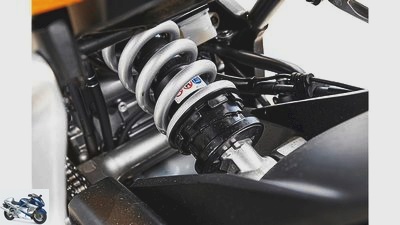
24/29
The damping of the directly linked strut cannot be adjusted. With a tight basic design, it can also cope with such a passenger.
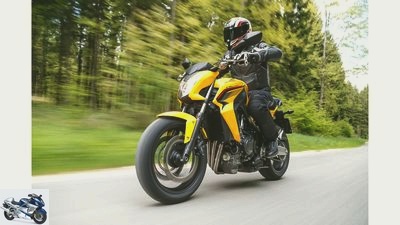
25/29
In addition to the low beam, the front mask also contains two blue shimmering position lights.
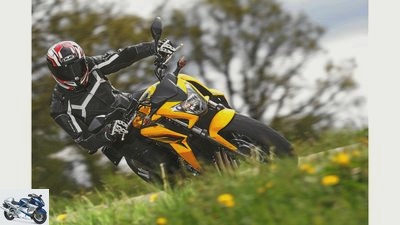
26/29
The successor to the Hornet 600 is stable – provided the pilot keeps a steady hand.
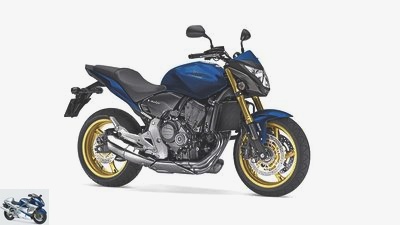
27/29
Honda Hornet 600: four-cylinder in-line engine, 102 hp, weight 207 kg,
0–100 km / h 3.5 seconds, Vmax 230 km / h, consumption 4.5 liters.
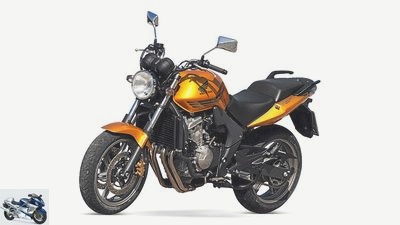
28/29
Honda CBF 600: four-cylinder in-line engine, 77.5 hp, weight 223 kg,
0–100 km / h 4.2 sec, Vmax 210 km / h, consumption 4.0 liters.
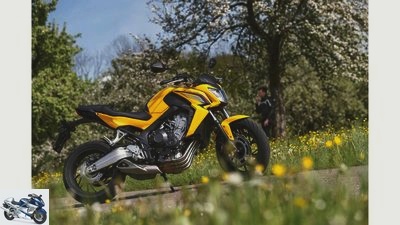
29/29
Honda CB 650 F in the top test
Just ride a motorcycle
Stand out at any cost? Let the others do that. The new Honda CB 650 F is not looking for a trainer to keep it in check. She just wants to ride a motorcycle with her pilot – and for this she brings a successful overall package to the start, as the top test shows.
If you were at a party, you would run the risk of the new Honda C.B 650 F might be overlooked. She doesn’t stand out uncomfortably through yelling, wears appropriate clothing and doesn’t just hang out at the bar. She is more of a clerk than a helicopter pilot – not entirely uninteresting, but far from glamorous. But down-to-earthness, solidity and honesty also develop their charm. So is the successor to the Honda Hornet injustice to discredit it as a bore in advance? A four-cylinder in-line engine at least no longer causes tears of joy in motorcyclists these days. At some point everyone drove a machine like that. The fact that the Honda CB 650 F then even takes to the field with a displacement of just 649 cubic meters doesn’t really make things any better. And with 87 HP nominal power at 11,000 tours you won’t get anyone off your stool. The barrel organs of the 1990s left a lasting impression.
Buy complete article
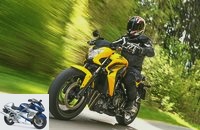
Honda CB 650 F in the top test
Just ride a motorcycle
Up to 6th gear without accelerating
In any case, it takes a moment longer to warm up with the Honda CB 650 F than with other Hondas. This is not due to the seating position or the geometry with a 64.5 degree steering head angle and 101 millimeters of caster within the usual scope of a naked bike, but rather to the annoying cold start behavior. In the age of computer-controlled injection systems, it should actually be a thing of the past that the engine speed slips to 2500 revs when the starter is pressed. Especially when the morning temperatures are in the double digits. Well, after about two minutes, the idling speed levels off at around 1200 revolutions: let’s go!
Fortunately, the clutch lever, which cannot be adjusted in width, requires little manual force, and first gear engages audibly, but not indecently loudly. The clutch engages late and sets the DID drive chain in rotation. A brisk start requires a short period of familiarization. When looking for the point of engagement, attentive pilots register the automatic idle gas increase when the clutch is engaged. If you want to, you can upshift up to sixth gear on the Honda CB 650 F without even having to accelerate – the electronics successfully prevent the engine from dying.
There were already Honda transmissions that could be operated much more precisely. Especially between the first and second as well as the second and third gear, the rear derailleur is bony and demands a courageous shift foot. On the other hand, the translation looks very successful, which the gear diagram does not necessarily reflect. The engine tenses its muscles from as little as 2500 tours and provides sufficient power with 50 Newton meters. This enables early upshifts. Even in city traffic you can drive carefree in fifth or sixth gear and easily swim with the sheet metal bodies. Obviously, with this moderately short-stroke engine (bore: 67 mm, stroke: 46 mm), you shouldn’t expect a start like an electric bike. But the tamely designed control times of the eight inlet and eight exhaust valves operated by bucket tappets clearly ensure that the combustion chamber is well filled in the lower and middle speed range. So promise kept. Nice!
Cheer up to the limiter
The response behavior is likely to be more sensitive and the load change reactions less pronounced. After a long period of pushing, the Honda CB 650 F jerks strongly when the throttle valves are turned on. Sometimes the load change reactions even cause unrest in the otherwise good stability when cornering and ruin the line.
Technically, however, the assumption made at the beginning of the cost pressure for the engine tilted 30 degrees forward cannot be confirmed. The piston skirts, for example, are designed asymmetrically to reduce friction losses on the cylinder walls. There are also ventilation holes in the crankcase, which are intended to reduce pressure fluctuations and pumping losses at high speeds. And finally, the test bench diagram also rejects any doubt that the four-cylinder could be a savings number. Because not only does the unit exceed the manufacturer’s specifications by 2 HP and Newton meters each, it also convinces in practice with a broadly usable speed range.
If you are traveling in normal country road mode, you can upshift at 5000 tours without becoming a traffic obstacle. If it occurs to you to stick with the GS rider who has just overtaken you, the speed should not drop below 6000 revs. From here on, the four-cylinder fires properly in the combustion chamber and pushes the 180 rear tires powerfully. If the BMW driver has noticed the chase and wants to flee forwards with his increased power, the throttle valves of the Honda CB 650 F can confidently be left open until the pistons whiz through the cylinders up to 11,000 times a minute. Because even in the upper third of the speed, the engine can still saddle up a shovel and turns brightly into the limiter.
Honda CB 650 F without high-frequency screeching
Anyone who is puzzled again because he had saved on the biological hard drive that the now replaced Honda Hornet made a full 102 hp can be reassured. It’s true: Despite the larger displacement, the Honda CB 650 F does less. But you won’t really miss the last few horses. The engine never struggles to propel the 212 kilograms forward on level ground.
The soundscape released by the chic four-in-one exhaust system always remains in the background. In the lower third of the speed, the water-cooled unit works so quietly that you can hear the fuel pump working. It is logical that the volume increases with higher speed. A high-frequency screeching, as known from other 600 cubic high-performance engines, cannot be heard from the Honda CB 650 F. A clear plus point.
Unexpected strong vibrations
Another circumstance bothered the driver of the Honda CB 650 F: from 5000 tours, the driver’s hands and feet start to tingle. Unexpectedly strong vibrations penetrate the entire motorcycle from the engine and become more dominant with increasing engine speed. Well, this four-cylinder is definitely not a smooth candidate.
The Honda CB 650 F scores with other virtues. At a seat height of 800 millimeters, a 1.79 meter tall pilot will also find a comfortable seat. The seat tilts slightly in the direction of the 17.3 liter tank, the handlebars stretch out gently towards the driver. So you sit very actively on the Honda with a relaxed knee angle and upright upper body and only perceive the knee joint as slightly too wide. Anyway, the well-known Honda feel-good feeling can also be found on the CB.
Zags extremely light-footed around the corner
So you can immediately look forward to the brilliant handling qualities of the yellow racer right from the start. Despite the unnecessary 180 millimeter wide rear tire (Dunlop Roadsmart 2), the Honda CB 650 F zigzags around the corner and acknowledges short-term line corrections with military obedience. The Japanese have shown a good hand there. Because even if you perceive the handiness rather than nervousness on the first few meters, you quickly learn to appreciate the playful navigation of the 650s. The post-yellow motorcycle with a highway consumption of an acceptable 4.4 liters can also express delivery!
Anyone who takes the Honda CB 650 F seriously will be pleased with the adequate damping of the spring elements as well as the torsional stiffness of the partly oval steel bridge frame. The telescopic fork with a diameter of 41 millimeters cannot be adjusted in its setup, but its standard design impresses with good response behavior and firm damping. The same applies to the monoshock controlled directly on the cast aluminum swing arm, which can be adjusted seven times in preload to individual needs. Only the suspension comfort should be a touch more luxurious for the faint of heart testers. But well, you can’t have everything. After all, your best friend isn’t a millionaire either and just throws money around.
The successor to the Hornet 600 is stable – provided the pilot keeps a steady hand.
But you can let it fly pretty well with the Honda CB 650 F. It is true that it does not steer completely neutrally in a lean position and requires a slight counter pressure on the inside of the handlebars when cornering. But once it is on course, it pulls its course stoically and calmly and does not allow itself to be disturbed by bumps or potholes. However, the driver should implement spontaneous course corrections with the necessary sensitivity: Because of the agile handling, one tugs one lane too hard on the handlebars and drives on a closer line around the corner than originally planned. Getting used to!
A good feeling for the brakes does not have to be found first. The dosage of the two-piston floating calipers can hardly be better. And in an emergency, the standard ABS prevents loss of control. The delay performances are not particularly likely to be a hit, but rather average.
And what is Honda now calling for this solid mid-range motorcycle? Not really little: 7955 euros are lush for a 650-cubic four-cylinder motorcycle. Especially with the stronger competition from Yamaha. But this wonderful looseness around the hips, these good-natured driving characteristics and the successful overall package will definitely find buyers. Let the others cultivate the extravagance. With the Honda CB 650 F you drive your motorcycle easily and easily. And that’s what it’s about!
Technical specifications
Engine: Water-cooled four-cylinder four-stroke in-line engine, two overhead, chain-driven camshafts, four valves per cylinder, bucket tappets, wet sump lubrication, injection, 4x Ø 32 mm, regulated catalytic converter, 343 W alternator, 12 V / 9 Ah battery, mechanically operated multi-disc oil bath clutch, six-speed gearbox , O-ring chain, secondary ratio 42:15.
Bore x stroke: 67.0 x 46.0 mm
Displacement: 649 cm³
Compression ratio: 11.4: 1
Rated output: 64.0 kW (87 hp) at 11,000 rpm
Max. Torque: 63 Nm at 8000 rpm
Landing gear: Bridge frame made of steel, telescopic fork, Ø 41 mm, two-arm swing arm made of aluminum, spring strut, directly hinged, adjustable spring base, double disc brake at the front, Ø 320 mm, double-piston floating calipers, disc brake at the rear, Ø 240 mm, single-piston floating caliper, ABS.
Cast aluminum wheels: 3.50 x 17; 5.50 x 17
Tires: 120/70 ZR 17; 180/55 ZR 17
Tires in the test: Dunlop Roadsmart 2
DIMENSIONS + WEIGHTS: Wheelbase 1450 mm, steering head angle 64.5 degrees, caster 101 mm, spring travel f / r 120/128 mm, permissible total weight 396 kg, tank capacity 17.3 liters.
Service data:
Service intervals: 12,000 km
Oil and filter change: every 12,000 km, 2.9 liters
Engine oil: 10W30
Telescopic fork oil: 10W
Spark plugs: Denso U27FER9, NGK CREH9
Idle speed: 1250 ± 100 / min
Tire pressure: solo (with pillion passenger)
front / rear: 2.5 / 2.9 (2.5 / 2.9) bar
Guarantee: two years
Colors: yellow, black, silver, tricolor (blue / white / red)
Price: 7690 euros
Additional costs: 265 euros
The 90 hp class is gaining momentum
In the middle of the middle class
As broad as the middle class is diversified these days, one should think about a new nomenclature. The CB 650 F is located exactly in the middle.
At the turn of the millennium, the performance classes of mid-range motorcycles were still clearly structured. There were some who, partly because they were classified in a cheaper insurance class, made a maximum of 78 hp, and the others who were around the 100 hp mark. A rather new phenomenon in the medium displacement class are motorcycles like the new CB 650 F, which starts with around 90 hp. For years, the BMW F 800 R with its parallel twin and 87 hp was pretty much alone in this region. Either the competition had significantly less power, such as the Yamaha XJ6, Kawasaki ER-6n or Suzuki Gladius with 70 to 80 hp, or significantly more hp like the Honda Hornet (102 hp), Triumph Street Triple 675 (106 hp) and Kawasaki Z. 800 (113 hp).
Only the Aprilia Shiver (95 PS), Ducati Monster 796 (87 PS) and Suzuki GSX 650 F (86 PS) joined the successful BMW F 800 R. With the new CB series, Honda is trying to do it with two models To make competition difficult. Interestingly, the Japanese manufacturer is replacing two performance classes of its previous model range: In addition to the sleek and agile Hornet 600 with its 102 hp, the all-rounder CBF 600 with 78 hp is no longer built. The latter was only available with a clad front section anyway, and with the CB 600 F it already had a strong competitor in-house.
Honda is now tightening its model range with the CB 650 F and CBR 650 F. To what extent this step in the direction of the 90 hp class is the right one remains to be seen. It is at least clear that both the Hornet and the naked CBF 600, which was built until 2012, enjoyed great popularity.
Noticed
Noticeable positively: the storage compartment.
The maintenance-friendly battery and fuse box are housed under the bench seat. In addition, the uncovered storage compartment offers space for a pair of gloves and a rain suit. If you want to lash your luggage, you can also fold out two loops below the pillion seat.
Noticeable negatively: The sticker on the side panel that was not painted over.
That is not how it works! The fact that the stickers on the side panel are not painted over is noticeable after a few kilometers: the adhesive has already visibly loosened in the front part. Even if the brake lever is fortunately adjustable in width: Why doesn’t the clutch lever enjoy the same benefit?
Tire transparency
Since the comparability and objectivity of the tests have the highest priority for MOTORRAD, the manufacturers are encouraged to make the test motorcycles available on the same soles as the machines are in the trade. In the case of this top test, it unfortunately didn’t work. Honda put the motorcycle with Dunlop’s Roadsmart 2 in front of our door. The OEM tires, however, are Dunlop D222 and Metzeler Z8 Interact “F”. For reasons of time, these could not be countered before the editorial deadline. We apologize for this fact. In the mid-range comparison test, which is planned for MOTORRAD 14/2014, the small Honda will then compete on original equipment manufacturer tires.
MOTORCYCLE measurements
engine.
Performance
Top speed: 205 km / h
acceleration
0-100 km / h 3.8 sec
0–140 km / h 6.7 sec
0-200 km / h21.2 sec
Draft
60-100 km / h 4.8 sec
100–140 km / h 5.8 sec
140–180 km / h 8.8 sec
Speedometer deviation
Effective (display 50/100): 48/98 km / h
Tachometer deviation
Display red area: 12 200 / min
Effective: 12,200 / min
consumption
Country road: 4.4 l / 100 km
At 130 km / h: 4.6 l / 100 km
Theor. Range of the country road: 393 km
Fuel type: Super
DIMENSIONS + WEIGHTS
L / W / H: 2160/910/1260 mm
Seat height: 800 mm
Handlebar height: 1065 mm
Turning circle: 5440 mm
Weight with a full tank: 212 kg
Payload: 184 kg
Wheel load distribution front / rear: 50.7 / 49.3%
transmission.
Okay, 650 cubic centimeters will not overwhelm anyone. But whoever accuses the Honda of having a bloodless drive is doing you an injustice. The four cylinders produce usable propulsion from as little as 3000 tours. If you are aiming for a brisk overtaking maneuver, you should aim for at least the 6000 mark. From here on, the CB plays with fire and turns happily into the limiter.
Driving dynamics
Handling course I (fast slalom)
Lap time: 20.8 sec
Reference KTM 690 Duke: 19.0 sec
Vmax at the measuring point: 101.5 km / h
Reference KTM 690 Duke: 110.0 km / h
The small Honda is handy, but has to be guided through the fast course with a hard hand, as the motorcycle stiffens with increasing speed. Due to the hard throttle response, it is difficult to drive a clean line.
Handling course II (slow slalom)
Lap time: 29.3 sec
Reference Triumph Street Triple: 27.3 sec
Vmax at the measuring point: 52.9 km / h
Reference Triumph Street Triple: 59.0 km / h
Here the Honda circles the pylons with ease. At the turning point, the Honda understeers a little. The feedback is good.
Circular path (Ø 46 meters)
Lap time: 11.1 sec
Reference Triumph Street Triple: 10.2 sec
Vmax at the measuring point: 50.150.1 km / h
Reference Triumph Street Triple: 56.4 km / h
If you are on a steep incline you have to correct the line carefully. To the left, first put on the footrest, then the side stand and extension arm.
Brake measurement from 100 km / h
Braking distance: 43.4 m (remaining speed 20.9 km / h)
Reference Triumph Street Triple: 41.5 m
Brakes.
The brake metering couldn’t be better. The speed can be reduced in a finely controllable manner with little manual force. However, if you ask the two-piston floating calipers to take a bold bite, you will not reap any sensational deceleration values. The ABS effectively prevents the wheels from locking, but 8.9 m / s² is only average in this category.
MOTORCYCLE scoring
engine
| maximum number of points |
Honda CB 650 F. | |
| Draft | 40 | 20th |
| acceleration | 40 | 19th |
| Top speed | 30th | 14 * |
| Engine characteristics | 30th | 19th |
| Responsiveness | 20th | 13 |
| Load change | 20th | 12th |
| Smoothness | 20th | 12th |
| coupling | 10 | 8th |
| circuit | 20th | 12th |
| Gear ratio | 10 | 8th |
| Start | 10 | 8th |
| total | 250 | 145 |
* Evaluated: MOTORCYCLE measurement 205 km / h (factory specification 195 km / h)
There is no question that Honda put a lot of effort into the engine. The envisaged goal of planting a decent thrust from below into the four-cylinder without affecting its revving ability has also been achieved. Unfortunately, the four-cylinder is noticeable for its hard response and rough load change reactions. These are pronounced and like to ruin the targeted line for the pilot. In addition, the engine vibrates noticeably from 5000 revolutions. The transmission cannot always be operated precisely.
landing gear
| maximum number of points |
Honda CB 650 F. | |
| Handiness | 40 | 30th |
| Stability in turns | 40 | 27 |
| Steering behavior | 40 | 28 |
| feedback | 10 | 8th |
| Inclined position | 20th | 16 |
| Straight-line stability | 20th | 15th |
| Suspension tuning in front | 20th | 13 |
| Chassis set-up at the rear | 20th | 13 |
| Adjustment options undercarriage | 10 | 1 |
| Suspension comfort | 10 | 6th |
| Driving behavior in the passenger | 20th | 14th |
| total | 250 | 171 |
In terms of chassis, the naked bike doesn’t have to hide behind the competition. Thanks to the well-balanced chassis setup, great feedback from the front wheel and a superb freedom from lean angles, the CB can be used pretty quickly. You can even cope with the fact that only the preload of the strut can be adjusted and the suspension comfort is not sensational. Those who like to ride with a pillion can do nothing wrong with the Honda. It offers sufficient reserves and continues to drive inconspicuously when accompanied. Unfortunately, it then touches down earlier.
everyday life
| maximum number of points |
Honda CB 650 F. | |
| Ergonomics driver | 40 | 30th |
| Ergonomics pillion | 20th | 12th |
| Windbreak | 20th | 1 |
| view | 20th | 13 |
| light | 20th | 13 |
| Furnishing | 30th | 14th |
| Handling / maintenance | 30th | 17th |
| Luggage storage | 10 | 4th |
| Payload | 10 | 4th |
| Range | 30th | 25th |
| processing | 20th | 13 |
| total | 250 | 146 |
The driver finds a comfortable seat where all limbs can easily find their predetermined place. As usual, the tool kit is under the seat and is well sorted. Long-distance travelers can also use four luggage hooks (plus passenger footrests). The payload, on the other hand, is not extremely generous at 184 kilograms, but it is still satisfactory. Thanks to the acceptable consumption of 4.4 liters and the 17.3 liter fuel barrel, stages of up to 393 kilometers are possible without refueling.
security
| maximum number of points |
Honda CB 650 F. | |
| Braking effect | 40 | 26th |
| Brake metering | 30th | 24 |
| Braking with a passenger / fading | 20th | 13 |
| Righting moment when braking | 10 | 7th |
| ABS function | 20th | 12th |
| Handlebar slapping | 20th | 14th |
| Ground clearance | 10 | 7th |
| total | 150 | 103 |
The dosage of the brakes is impeccable. Only the braking effect leaves a little to be desired. The ABS regulates fine, but still does not allow shorter braking distances. With the mounted Dunlop Roadsmart 2, the CB stood up slightly when braking in an inclined position.
costs
| maximum number of points |
Honda CB 650 F. | |
| guarantee | 30th | 15th |
| Consumption (country road) | 30th | 22nd |
| Inspection costs | 20th | 19th |
| Maintenance costs | 20th | 12th |
| total | 100 | 68 |
With a two-year guarantee and inspection intervals of 12,000 kilometers or every two years, the small Honda scores satisfactorily.
| maximum number of points |
Honda CB 650 F. | |
| Overall rating | 1000 | 633 |
| Price-performance note | 1.0 | 1.3 |
The decent overall performance, together with the price of 7955 euros, results in a very good price-performance ratio.
Conclusion
The overall package is convincing! With a modern design, a solid engine and impeccable driving characteristics, the CB 650 F does its manufacturer credit. It shows that even a small four-cylinder can tense the muscles below. Only the vibrations from 5000 tours and the responsiveness of the engine tarnish the image of the everyday naked bike.
Related articles
-
fact top test Honda CBF 600 package deal All-round carefree packages are in ?? not only for summer holidays: With variable ergonomics and very …
-
Photos: fact 11 pictures Honda 1/11 Honda CBR 600 F Honda 2/11 Honda CBR 600 F Honda 3/11 Honda CBR 600 F Honda 4/11 Honda CBR 600 F Honda 5/11 Honda CBR …
-
fact top test Honda Varadero 1000 pleasure ship Truly a monumental motorcycle, weighing 267 kilograms, as high as a cathedral, comfortable and fast. That…
-
BMW R nineT and BMW R 1200 R in the test
www. 39 Pictures www. 1/39 When the R 1200 R drives off, the eyes stay on the R nineT, if it rolls up, all eyes follow it. So…
-
KTM 690 Duke and Yamaha MT-07 in comparison test
www.factstudio.de 25 pictures www.factstudio.de 1/25 Power on the crankshaft. Measurements on the Dynojet roller test stand 250, corrected according to 95/1 / EG, …
-
Comparative test of mid-range naked bikes
Artistic comparison test middle class naked bikes Honda Hornet 600, BMW F 800R and Yamaha XJ6 In the middle class the post is really going on. With…
-
Kawasaki Ninja 300 and KTM RC 390 in the test
31 pictures 1/31 KTM RC 390. 2/31 comparison test Kawasaki Ninja 300 and KTM RC 390. 3/31 comparison test …
-
Honda NC 700 S and Yamaha XJ6 ABS in the test
17 pictures 1/17 Honda NC 700 S and Yamaha XJ6 ABS in a 48 HP comparison test. 2/17 Honda NC 700 S and Yamaha XJ6 ABS …
-
Honda CB 1000 R, Kawasaki Z 1000 SE, Yamaha FZ1 in the test
www. 48 pictures www. 1/48 On the MOTORRAD test tracks in southern France, Honda’s CB 1000 R and Yamaha’s FZ1 stand for a test of strength …
-
Artificial top test Honda Hornet 900 which stands out Low weight, good brakes, a powerful super sports engine: proven ingredients for a sporty …